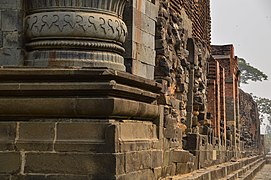Adina Mosque
The vast architecture resembles the hypostyle of the Umayyad Mosque in Damascus, a style that was used during the introduction of Islam in new areas. The early Bengal Sultanate harbored imperial ambitions after having defeated the Delhi Sultanate twice in 1353 and 1359. The Adina Mosque was commissioned in 1373.
Design



The design of the mosque incorporated Bengali, Arab, Persian and Byzantine architecture. It was built with rubble masonry that was covered with brick, stone, coatings of stucco, plaster, concrete, glazing or lime smoothing. Stone flowers were integrated into the arches of the interior and exterior all around the building. Its construction reused materials or incorporated motifs inspired by pre-Islamic Hindu and Buddhist structures. It had a rectangular hypostyle structure with an open courtyard. There were several hundred domes. The structure measured 172 by 97 m. The entire western wall evokes the imperial style of pre-Islamic Sasanian Persia. The mosque's most prominent feature is its monumental ribbed barrel vault over the central nave, the first such huge vault built in the subcontinent, and another feature shared in common with the Sasanian style. The mosque consciously imitated Persianate imperial grandeur. The prayer hall is five aisles deep, while the north, south and east cloisters around the courtyard consist of triple aisles. In total, these aisles had 260 pillars and 387 domed bays. The interior of the courtyard is a continuous façade of 92 arches surmounted by a parapet, beyond which the domes of the bays can be seen. The interior elevated platform, which was the gallery of the Sultan and his officials, still exists. The Sultan's tomb chamber is attached with the western wall.
History

Medieval Bengal
The mosque was built during the reign of Sikandar Shah, the second Sultan of the Ilyas Shahi dynasty of the Bengal Sultanate. The mosque was designed to display the kingdom's imperial ambitions after its two victories against the Delhi Sultanate in the 14th century. Cut off from both north India and the Middle East in the late 8th/14th and early 9th/15th centuries, Muslim Bengali monarchs enthusiastically looked far to the west for cultural inspiration. Thus, for example, the inscription on the Ādīna Mosque describes Sultan Sekandar as “the exalted Sultan, the wisest, the most just, the most liberal and most perfect of the Sultans of Arabia and Persia (ʿArab o ʿAjam)” (S. Ahmed, p. 38). A few parts of the mosque's exterior wall have carvings like elephants and dancing figures. Inscriptions on the mosque proclaimed Sikandar Shah as "the exalted Sultan" and the "Caliph of the faithful". The Sultan was buried in a tomb chamber attached to the wall facing the direction of Mecca.
The mosque was located in the historic city of Pandua, a former capital of the Bengal Sultanate. Pandua was a thriving and cosmopolitan trading center during the period of the sultanate.
Colonial India
The mosque was damaged by earthquakes in the 19th century. It fell into disuse. Much of Pandua also became part of the wilderness.
Independent India
Activists from Bharatiya Janata Party and Vishva Hindu Parishad have claimed that the mosque was built by demolishing an "Adinath Temple", and hence must be restored to the Hindus.
Gallery

-
Shiva Linga in Adina Mosque
-
Arabic inscriptions on the stone walls inside the Mosque
-
Arches and columns in the interior of Adina Mosque. The elevated platform was the royal gallery where the Sultan prayed.
-
Central prayer hall in the mosque
-
Carving of Ganesha etched on the stone wall
-
Tomb of Sultan Sikandar Shah
-
Detailed arabesque
-
The building seen through a peep hole
-
Corner of the building
-
Arches inside the mosque
-
A column and an Arabic inscription from Adina Mosque, now in the British Museum
See also
References
- ^ "List of Ancient Monuments and Archaeological Sites and Remains of National Importance". West Bengal. Archaeological Survey of India. Archived from the original on 27 June 2014. Retrieved 17 April 2020.
- ^ Hasan, Perween (15 August 2007). Sultans and Mosques: The Early Muslim Architecture of Bangladesh. I.B.Tauris. ISBN 9781845113810 – via Google Books.
- ^ Banerji, Naseem Ahmed (1993). The architecture and architectural decoration of the Adina Mosque, Pandua, West Bengal, India: The problem of the conjoined Buddhist, Hindu and Islamic motifs in the mihrab niches - ProQuest (Doctor of Philosophy in Art History thesis). ProQuest 304044113.
- ^ Banerji, Naseem Ahmed (1 January 2002). The Architecture of the Adina Mosque in Pandua, India: Medieval Tradition and Innovation. Edwin Mellen Press. ISBN 9780773472099 – via Google Books.
- ^ electricpulp.com. "BENGAL – Encyclopaedia Iranica".
- ^ Datta, Rangan (13 October 2022). "Beauty in ruins: Tracing the history of Pandua's glorious past". The Telegraph. My Kolkata. Retrieved 12 September 2023.
- ^ Eaton, Richard Maxwell (1996). The Rise of Islam in the Bengal Frontier, 1204-1760. University of California Press. pp. 40–50. ISBN 0520205073.
- ^ "Adina Mosque". Banglapedia.
- ^ "A Journey through India's Major Shrines and Controversies". Outlook India. Retrieved 18 March 2024.










